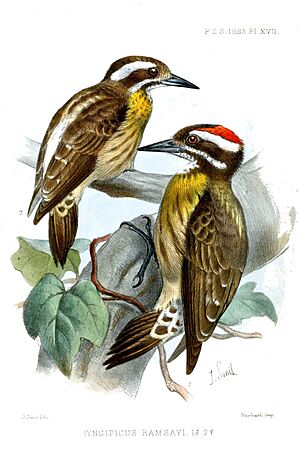Sulu pygmy woodpecker facts for kids
Quick facts for kids Sulu pygmy woodpecker |
|
|---|---|
 |
|
| Conservation status | |
| Scientific classification | |
| Genus: |
Yungipicus
|
| Species: |
ramsayi
|
| Synonyms | |
|
Picoides ramsayi |
|
The Sulu pygmy woodpecker (Yungipicus ramsayi) is a small bird found only in the Philippines. It is also known as the Sulu woodpecker. This bird belongs to the woodpecker family, called Picidae.
Scientists used to think it was the same as the Philippine pygmy woodpecker. But now, many believe it is its own special kind of bird. It is closely related to the Philippine pygmy woodpecker and the Sulawesi pygmy woodpecker. This woodpecker lives in warm, wet places like lowland forests, mangrove forests (forests by the sea), and even on farms. Sadly, it is threatened because its home is disappearing.
Contents
What Does the Sulu Pygmy Woodpecker Look Like?
The Sulu pygmy woodpecker is a small bird. It has dark brown feathers on its back. You might see some white spots there too. Its bottom (rump) is white. Its throat and belly are also white, with some light stripes. The sides of its chest are a buffy (light yellowish-brown) color.
Head Markings
Look closely at its head! It has dark brown and white stripes that go back and forth. The front part of its head is dark. Female woodpeckers have a dark back of the head. But male woodpeckers have a bright red patch there. This makes them easy to tell apart.
Unique Features
This woodpecker is quite unique. No other woodpeckers of its size live in the same areas. So, if you see a small woodpecker in the Sulu Islands, it is likely this one! Its call is a fast, strong trill (a series of quick notes).
Where the Sulu Pygmy Woodpecker Lives and Its Status
The Sulu pygmy woodpecker lives in many different places. It can be found in forest clearings, at the edge of forests, in mangrove areas, and even in farm fields. It also lives in untouched forests. However, some people think it avoids very dense forests. It has been seen at heights up to 550 meters (about 1,800 feet) above sea level.
Understanding Its Home
We do not know a lot about exactly what kind of home this bird prefers. It can live in places where the habitat has been changed a bit. This suggests there should be more of them than there are.
Why It Is Vulnerable
The IUCN Red List says this bird is a vulnerable species. This means it is at risk of becoming endangered. There are an estimated 2,500 to 9,999 adult birds left.
The biggest threat to this woodpecker is habitat loss. Its forest homes are being cleared for many reasons. These include legal and illegal logging, mining, and turning land into farms or palm oil plantations. Cities are also growing, which takes away more land.
Other Threatened Birds in the Sulu Archipelago
Because so much habitat is being lost in the Sulu Archipelago, many other birds that live only there are also threatened. These include the Sulu hornbill, Tawitawi brown dove, Blue-winged racket-tail, and Sulu hawk-owl.
Helping the Sulu Pygmy Woodpecker
Right now, there are no special programs just for this woodpecker. But people have suggested ways to help. These include:
- Doing more surveys to learn about where they live and how many there are.
- Working to protect the forests that are left.
- Teaching local people about the importance of protecting these birds and their homes. This can make people proud of their unique wildlife.


